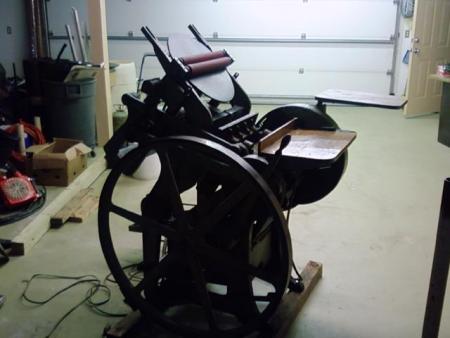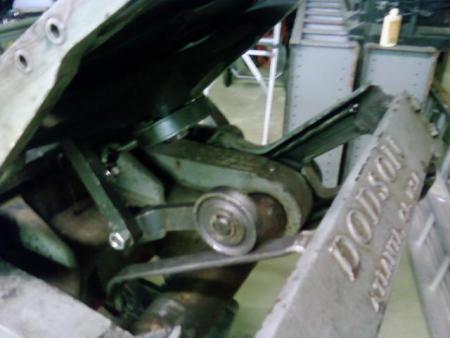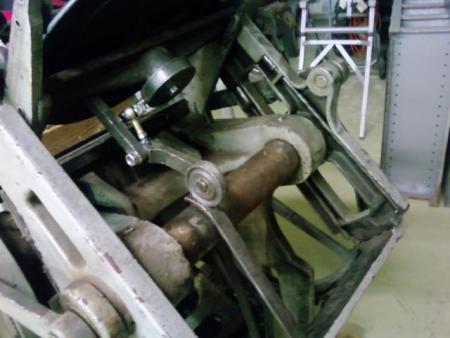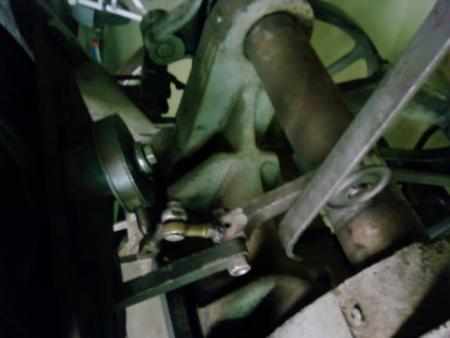ink disk doesn’t turn on dodson (C&P) pics
Hello,
I just got in my new press, it is a Dodson 10x15. From what I have read here and just from comparing photos, it is very close or even a rebranded c&p new series, but I can not find any photos with a similar mechanism that turns the ink disk. It appears original, but I haven’t been able to find much on the dodsons.
Has anyone seen a setup like this that turns the disk? Basically, There is a wheel attached to the frame close to the disk that rides a bar attached to the nameplate. as the press opens and closes, the wheel moves up and down and is attached to a lever that moves a one way clutch bearing on the bottom of the ink disk. Everything works except the outer ring on the bearing doesn’t grip the inner surface of the ink disk. The outer bearing ring moves about an inch with each impression. Sorry if it is a confusing explanation, I can put up more pictures if needed.
The photo with the wheel trapped under the bar instead of riding it is how it was when I received the press, but since it doesn’t move I figured out that was a useless configuration and changed it.
Any experience with this bearing situation would be greatly appreciated, I don’t have much experience with them!
thank you for your time!
-derek

0622091447-01.jpg

0624091736-02.jpg

0624091737-00.jpg

0624091737-01.jpg

0622091446-00.jpg
here is one of the inside of the bearing.
thanks again!
0624091711-00.jpg
If the outer ring is turning, but doesn’t move the inner mechanism, the inner three rolls must be slipping on the surface of the outer ring instead of grabbing on and running with it in order to creep up the “ramps” to grip the inner device and turn the hub.
If it appears that there is significant wear to the outer surface of the rolls, you might be able to add a bit of shim tape to the longer surface they roll against to force them out a smidge to contact the outer ring. Also, although it may seem counterproductive, a bit of dry lubricant on the flat surfaces might allow the rolls to move more smoothly.
If there is too much lube, the rolls might just slip on the outer ring and not push against the “ramps” to get the disk moving.
This type of bearing is often used in delivery tape mechanisms, and although it doesn’t provide the same positive grip as a lever escapement, it is much quieter. Get it working and enjoy the quiet.
Take a close look and see where there is wear and try a few things to eliminate the effect.
I believe also that this kind of clutch must be bone dry of lubricant — it relies on friction between the rollers and the outer ring/disc and any lubricant will prevent that. Also, it’s hard to tell but it looks like the outer rim that the rollers bear on is what is turned by the advance mechanism. If so then I would guess only one roller would engage at a time, or maybe two, since gravity hasn’t been repealed yet. That makes good friction even more important. You might try roughing up the inner surface of the driving ring, but the mechanism shouldn’t need that.
Bob
Derek,
I cant tell you about your particular press, but I might be able to give you some ideas on the mechanism that spins your disk.
My press has a similar device, a clutch/friction drive - and at least in my case oil/lubrication doesn’t seem to impact its function (it actually has an oil hole specifically for lubrication of the internal components).
I modeled up a quick illustration of that assembly off my press (shown with a few cut-aways to view the internals). I think what may be missing from yours is a spring at each wheel/roll. In my drawing you’ll notice each roll has a “pusher” that is spring loaded. This pusher keeps the roll shoved into the corner created between the ledge it rests on & the outside “cap”. With the spring-loading, as soon as the cap turns in the reverse direction the roll is pinched into the corner - providing the drive.
I did have trouble with mine not so long ago, where it started behaving intermittently (random turning of the ink disk & sometimes not at all). When I looked inside this device I found that the rolls had worn flat spots on them - causing them not to move into the position where they’d be pinched. I say this because the idea of wear was already mentioned - mine was/is worn too, but simply building a new set of rolls got it working like new again. I think the beauty of this design is that it can actually compensate for quite a bit of wear & still function as intended.
Also I wanted to note that I believe all three rolls should engage simultaneously. Given the natural slop in the assembly, balanced/opposing forces might be the only way they can get a “bite” into the cap/housing.
-Jason
Ink Disk.jpg
Jason, I wondered about the springs — I thought this type of clutch used a spring on each roller, but seeing none in the photo I assumed gravity was the “spring”. Thanks for the clarification and very fine drawing.
Bob
Thanks Bob - Its a consequence of my real life (the one that pays the bills) sometimes I just do better with a picture.
-J
Thank you so much everyone for the help. I will be working on it tomorrow with all your wonderful advice. I’m glad to know other people have a similar setup working for them.
and thank you jason for the illustration. I really appreciate it.
-derek
I have it working now. My center thing doesnt have cavities for a spring to sit in, so I took a spring and cilpped off one loop of it where it still provided tension but could be compressed to the thickness of the wire, and put a drop of superglue to hold it in place. It works really well.
thanks everyone!
Derek,
Great to hear - I was wondering if there was a pocket in there for a spring or not. Either way, if you got it working that’s what matters.
I don’t see any reason why your cut springs shouldn’t hold up, but you did mention some super glue to hold things in place - If the glue gives up after some use, you might also think about trying a leaf-style spring.
Every once and a while I need some flat spring-steel for something like this & found that a piece of steel strapping, like used for shipping & crated items, works well for bending into a “v” or “z” shape spring. Being square-ish I think you could size these to where they’d just stay put without any fasteners/adhesive.
-J